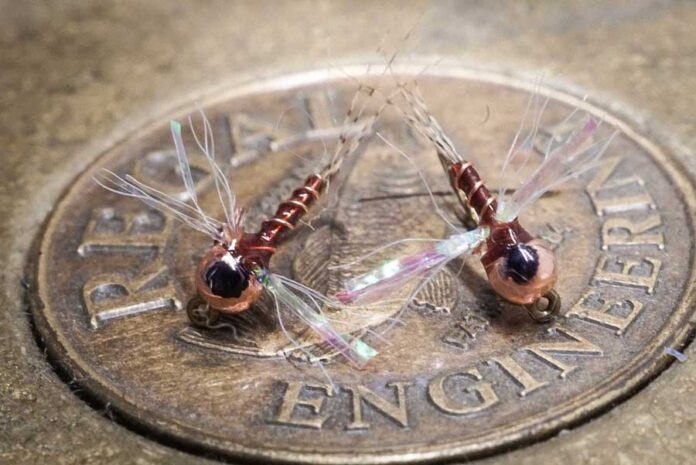Written by: George Daniel, Livin On The Fly
Photo by George Daniel
I have a confession to make: I write these articles to self-medicate.
I share all the mistakes and troubles I have on the water to provide countless examples
of what I hope is our collective suffering. One recent experience highlighted the harsh
reality that my nymph boxes lacked nymphs of differing weights. What is one to
do when trout are feeding higher in the water column, and one has only
tungsten-beaded nymphs? Like I said before–suffer.
Contrary to popular belief, you can fish nymphs too deep, and today, with the European nymphing
phenomenon, I see few anglers using brass or non-beaded patterns. (I’m looking
squarely at myself here.) I now realize that there are times when I need to lighten up.
Last May on Pennsylvania’s famed Spring Creek, sulfur
spinners were on the water, and trout were feeding on partially sunken spinners
several inches below the surface. A
traditional spinner pattern (fished in the surface film) is usually a good
approach when spinners are on the water, but often the natural spinners (after
mating) float through riffles, where the choppy currents pull them below the
surface. These partially sunken insects create an easy meal for trout.
On this night, the trout were positioned to feed two to
three inches below the water. They were locked into this higher level to feed
on the sunken spinners, so they were not about to move downward to eat a
pattern near the bottom. I needed to present my nymph where the fish were. I
could have simply taken a traditional spinner pattern, placed a tiny #8 split
shot near the hook eye, and I would have presented the spinner at the correct
level. But I had forgotten to bring my dry box that night. All I had was my
tungsten bead nymphs, and every pattern was too heavy to fish just below the
surface film. I did manage to catch a few fish, but I know I would have had
greater success with lighter patterns (brass bead or non-bead), fished higher
in the water column. And the results for the next four nights of spinner falls
proved me right. Lighter nymphs meant a lot
more fish.
This concept of lighter weight nymphs applies to all season
scenarios. As my friend John Stoyanoff once told me, “George, you cannot tell
trout where to find your flies!” When fish feed high in the column, you have to
meet them where they are. This is especially true on insect-dense streams like
Spring Creek, where food is plentiful and trout don’t need to move from the
buffet line to pick a scrap off the floor. They know if they stay in the buffet
line (i.e. at the depth where the current transports the food), food will come
to them.
When trout feed high in the column, lighten up your nymph rig
and good things will happen. Now I always carry several brass and non-beaded
patterns, something I didn’t do that night last May. The next night? Different
story.
The fly at the top of this page is a simple sunken-spinner pattern I’ve used for several seasons. It’s a cross between a Higa’s SOS nymph and the late George Harvey’s Krystal Flash Spinner. You can tie this pattern with a brass bead or without a bead, and allow just the weight of the heavy wire and thin thread body to sink the fly.
Sunken Sulphur Spinner
Hook: TMC 2457 or any heavy wire hook
Bead: Copper (brass weight), 3/32-inch.
Thread/Body : Rusty brown, 8/0 or 70-denier.
Tail: Wood duck fibers.
Rib: Copper wire, small.
Wing: Pearl Flashabou.
Coating: Loon Flow UV Resin.
Note: Put a small dab of colored nail polish on the brass beadhead nymphs, to distinguish them from tungsten.
My favorite rig is to attach this lightweight sunken spinner 12 to 16 inches below a high-vis Sulfur dry fly. If you want to take your fly fishing to a higher level-sometimes you need to fish higher in the column!
George Daniel operates Livin On The Fly, a guide service in State College, Pennsylvania. He is also the author of Strip-Set: Fly-Fishing Techniques, Tactics, & Patterns for Streamers, as well as Dynamic Nymphing.
Credit: Source link





























